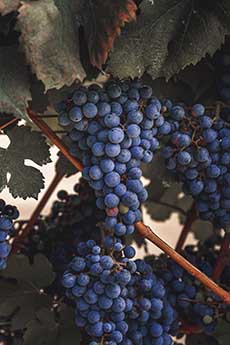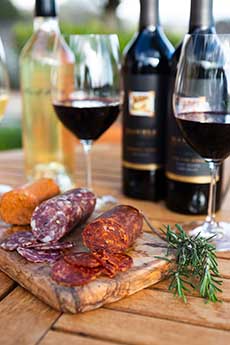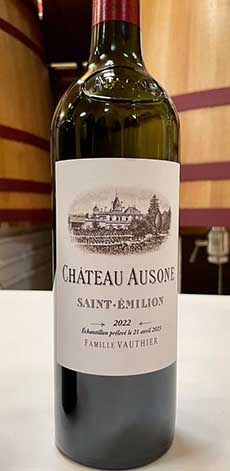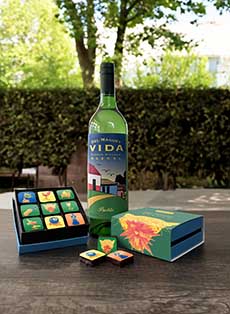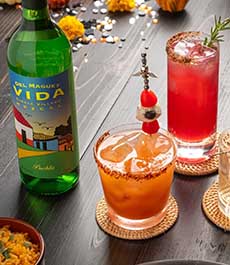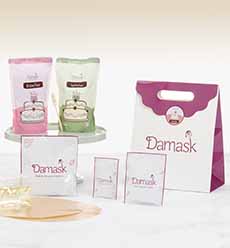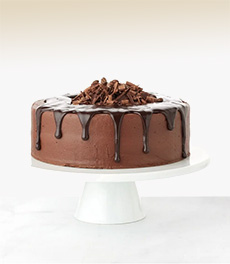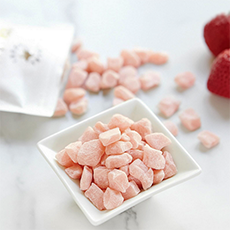|
Nutmeg is one of the so-called warm or sweet spices, delivering a subtle blend of sweet and spicy notes.
Nutmeg grows on trees but it’s not a tree nut. Rather, it’s the seed of a fruit of an evergreen tree. If you have a nut allergy, fear not.
While it’s a year-round asset in your kitchen, here’s why many people pull out nutmeg for the holiday season.
Below:
> Below: Different uses for nutmeg.
> Below: The history of nutmeg.
NUTMEG & CHRISTMAS
Nutmeg is often associated with the Christmas holidays because it’s used in many traditional holiday recipes.
During the holiday season, Europeans traditionally have used nutmeg in recipes for foods such as eggnog, pumpkin** pie, gingerbread cookies, and various other desserts—and savory dishes, too, such as nutmeg sausage.
The spice’s rich and earthy flavor and fragrant aroma add depth to these dishes and contribute to the overall festive atmosphere of Christmas.
One reason that most people reserved nutmeg for the holidays was the expense*** of the spice, before its wide availability in the 19th century.
Most spices were once considered luxury items and were associated with special occasions and celebrations. As a result, the tradition of using spices like nutmeg in holiday recipes has been passed down through many generations.
DIFFERENT USES FOR NUTMEG
Nutmeg is used in cuisines worldwide, adding flavor to both sweet and savory dishes with its warm, sweet, and slightly nutty flavor. Here are some common uses for nutmeg:
Baking: The sweet, slightly peppery undertones of nutmeg add a layer of sophistication to baked goods, including pies (apple pie, pumpkin pie), cakes, cookies, and pastries. It pairs well with flavors like cinnamon, cloves, and ginger in traditional holiday desserts.
Beverages: Nutmeg is a popular addition to hot drinks such as chai tea, eggnog, and mulled wine. It can also enhance the flavor of coffee and hot chocolate.
Breakfast: Add some nutmeg to pancake, waffle, and French toast batter; add some to coffee and hot chocolate; garnish your oatmeal.
Cheese Dishes: Nutmeg is a classic addition to cheese-based dishes like macaroni and cheese, gratins, and creamy pasta sauces. If you haven’t tried them in these ways, give it a shake or two the next time you cook.
Desserts: Nutmeg is often used in custards, puddings, ice cream, and other sweet treats to add depth and warmth to the flavor profile.
Meat and Poultry: Nutmeg can be used in spice rubs for meats and poultry, especially in combination with other warm spices, which include mace†. Mace is the lacy red membrane that surrounds the nutmeg seed (photo #6). It is also found in some sausage recipes.
Sauces and Soups: Nutmeg is used in creamy sauces like béchamel and Alfredo, as well as in creamy soups like parsnip and potato, to add a subtle, warm flavor.
Spice Blends: Nutmeg is often used in spice blends, including curry powder, garam masala, pumpkin spice, and ras el hanout.
Vegetables: Nutmeg complements the flavors of certain vegetables, especially spinach and winter squash. Grated nutmeg can be sprinkled on roasted or steamed vegetables for added depth.
When using nutmeg, use it in moderation, as its flavor can be quite potent. Freshly grated nutmeg often has a more vibrant flavor compared to pre-ground nutmeg, so some people prefer to buy whole nuts and grate them as they need them.
Medicinally, nutmeg is known as an anti-inflammatory and anti-thrombotic, and has anti-rheumatic, carminative (relieving flatulence), and stimulant properties.
In pregnancy and lactation, nutmeg is used in traditional medical practice for antenatal and postnatal treatment [source].
Nutmeg also yields an oil known as nutmeg butter. This creamy yellow butter is semi-solid and is used in many balms. It’s thought to soothe joint pain, elevate mood, and even treat the symptoms of colds.
Plus, thanks to its delicious scent, nutmeg is often found in beauty products—moisturizers, perfumes, and soaps—and dental products.
THE HISTORY OF NUTMEG
For millennia, the only people who knew about nutmeg were the residents of Indonesia, where the spice originated.
Nutmeg is spice that comes from the fruit of the Myristica fragrans evergreen tree (photos #4 and #5), native to the Moluccas, or Spice Islands, in Indonesia.
Nutmeg is not a nut: It is the seed of a fruit the size of an apricot (photo #6). The fruit, which is edible, has a single, large seed. This type of fruit is botanically known as a drupe (as are apricots and other stone fruits).
The name nutmeg is derived from the Latin nux muscatus, meaning “musky nut.”
The spice has long been highly prized for its aromatic and flavorful properties and has played a significant role in the global spice trade.
Origin and Discovery
The earliest evidence of the use of nutmeg comes in the form of 3,500-year-old potsherd residues from the island of Pulau Ai, one of the Banda Islands in eastern Indonesia. These islands were the only source of nutmeg and mace production until the mid-19th century [source].
The ancient Romans are believed to have known about nutmeg. Around the first century, C.E., the Roman author Pliny wrote of a tree that bore nuts with two flavors—presumably mace and nutmeg.
In the sixth century C.E., nutmeg use spread from Indonesia to India, then further west to Constantinople (modern Istanbul, Turkey).
By the 13th century, Arab traders had discovered the origin of nutmeg but kept the location a secret from European traders.
They introduced the precious spice to the West, bringing it to the Middle East and Europe.
During the Middle Ages, nutmeg was prized in Europe for use in medicine and as a preserving agent.
Wealthy nobles (or rather, their servants) used nutmeg graters to grind up the spice and add it to alcoholic drinks to show off their affluence [source].
Control Of The Spice Trade
Nutmeg played a crucial role in the colonial expansion of European powers. It was highly sought after for both culinary and medicinal purposes.
The demand for nutmeg and other spices drove European exploration and colonization efforts.
Christopher Columbus was trying to find a route to the Spice Islands when he discovered the Americas instead [source].
In the 15th century, the Banda Islands were facing invasion by the Portuguese. Explorers were sent on an expedition in 1512 by commander Albuquerque of the Portuguese fleet stationed in Malacca, Malaysia, to get the spice denied to them by the Turks.
The fleet’s mission was to locate the so-called “spice island.” Locate they did, that same year, and the commander of the boats, Francisco Serrao, became the first European to gather nutmeg and cloves from the archipelago.
At this point, the Portuguese gained control of the islands. Their reign made nutmeg more affordable and available in Europe—at least until the Dutch ousted them in the early 17th century.
The Portuguese Oust The Arabs
In the 16th century, the Portuguese expelled the Arabs and gained control over the Spice Islands trade.
The Dutch Expel The Portuguese
By the early 17th century, the Dutch managed to gain a monopoly over the nutmeg trade, establishing control over the Banda islands.
They destroyed nutmeg trees on other islands to limit production and create a lucrative spice monopoly.
They defended their monopoly fiercely, starting a brutal war. In 1621, they began to massacre and enslave many of the Banda natives. The Dutch ruled with an iron fist, destroying plantations and creating strict laws that were enforced by the death penalty.
Then the English arrived. The English and the Dutch East India Company engaged in conflicts over control of the Spice Islands.
It ended when the two countries signed the Treaty of Breda in 1667. Among other things, the Dutch handed over control of New Amsterdam (New York City) to the British in exchange for the Dutch retaining control of the nutmeg-producing Banda Islands.
The French Steal Plants
The Dutch held control of the islands for another hundred years or so. But in the 18th century, the French managed to smuggle nutmeg plants out of the Spice Islands.
During the Napoleonic Wars, French spice traders smuggled nutmeg trees out of Banda and over to Zanzibar, an island in the Indian Ocean off the coast of east-central Africa, and the Caribbean island of Grenada.
Thus commenced the downfall of the Dutch nutmeg monopoly and the affordability of nutmeg to consumers worldwide.
Today, Indonesia remains the largest producer of nutmeg, with Grenada a significant producer of nutmeg—so much so that it has been nicknamed “The Isle of Spice” and the country’s flag bears a nutmeg.
Other significant producers include India and Sri Lanka.
Nutmeg continues to be a popular and versatile spice in kitchens worldwide: in Indonesia, India, the Middle East (it’s an ingredient in the spice blend ras el hanout), Grenada and other Caribbean islands, European (France, Italy, and the Netherlands, the U.S., North Africa (particularly in Morocco and Tunisia, Malaysia and Singapore.
________________
*Pink Squirrel ice cream cocktail recipe: In a high-speed blender, combine 3 ounces crème de noyaux (an almond-flavored crème liqueur—you can substitute 1 part pomegranate juice and 3 parts amaretto), 3 ounces crème de cacao, 2 ounces heavy cream, and 3 scoops (9 ounces) vanilla ice cream. Blend on high until smooth. Divide the Pink Squirrel between 2 coupe glasses. Garnish with freshly grated nutmeg.
**Pumpkins and other squash were brought to Europe from Central America at the turn of the 16th century.
|
|

[1] Nutmeg nuts and a grater (photo © Pixabay | Pexels).
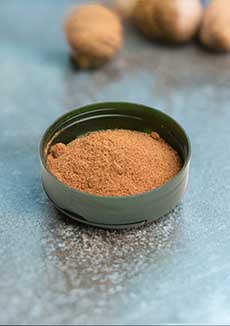
[2] Ground nutmeg (photo © Pereg).
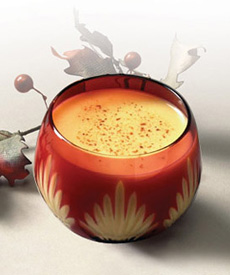
[3] Egg nog with a garnish of nutmeg (photo © All White Egg Whites).
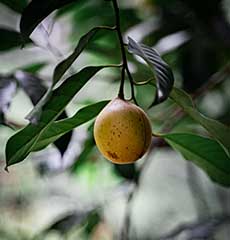
[4] Unripe nutmeg fruit on the tree (photo © Sandy Galabada | Unsplash).
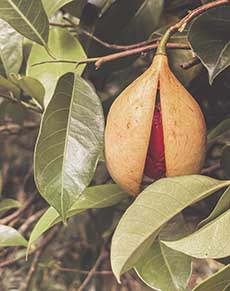
[5] Ripe nutmeg fruit, ready for harvest. When the fruit fully matures, it splits in two (photo © Tyler Gooding | Unsplash).
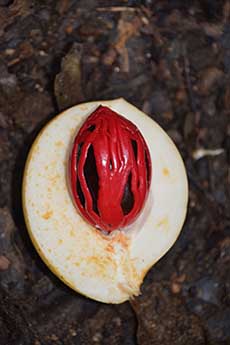
[6] The harvested fruit, showing the lacy membrane (the aril) over the nut (the seed of the fruit). It will be dried and turned into the spice mace. The inner nutmeg seeds are dried for six to eight weeks and turned twice daily before being sold whole converted into a powder or converted into a powder. The pericarp (fruit covering) is used to make jam or is finely sliced, cooked with sugar, and crystallized to make a fragrant candy (photo © Satyabrata Maiti | Pexels).
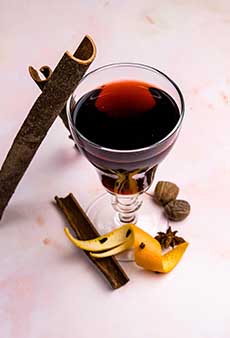
[7] Mulled wine is infused with nutmeg, cinnamon, cloves, and orange peel (photo © Edward Howell | Unsplash).
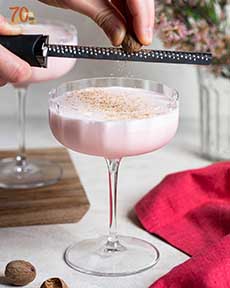
[8] Grating nutmeg onto a Pink Squirrel ice cream cocktail. The recipe is in the footnote below (photo © Gelsons Markets).

[9] Nutmeg is an ingredient in gingerbread (photo © Lydia Matzal | Unsplash).

[10] Nutmeg joins ginger, cinnamon, and molasses in gingersnap cookies (photo © Splendid Spoon).
|

